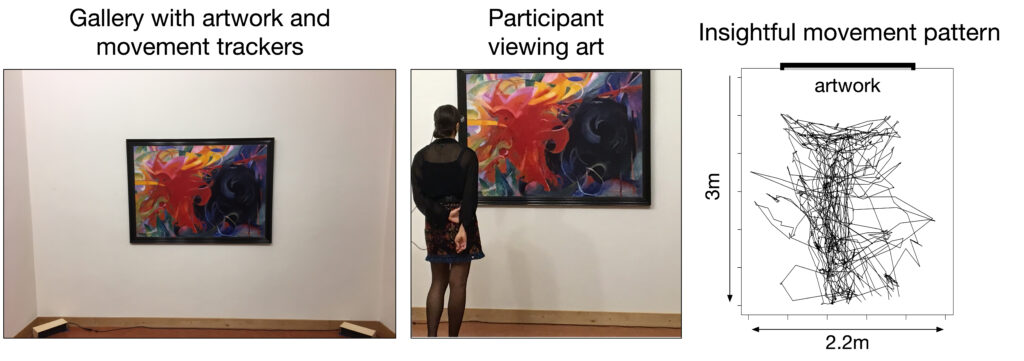written by Corinna Kühnapfel
When we visit a museum or gallery, we naturally move back and forth, side to side, and walk around to view the art from different angles.
A study by Corinna Kühnapfel (UNIVIE), Matthew Pelowski (UNIVIE), and Joerg Fingerhut (HUB), in collaboration with partners from the Faculty of Psychology and Department of Art History a the University of Vienna, as well as the Technische Universität Wien, found that these types of movements and an individual’s art experiences are connected. For example: changing viewing position more and taking a more dynamic movement pattern while in front of an abstract artwork was related to more insightful experiences. The study has been published in Empirical Studies of the Arts.
Embodied cognition claims that movement is central to our experiences, yet little attention has been paid to the actual ways viewers move in front of art, where they stand, how they approach or shift positions, and in which ways this impacts their personal art experiences.
To address this gap, this study, for the first time, objectively measured how individuals position themselves and dynamically move in front of an abstract artwork hung in a mock-gallery space. The movement was tracked with a new device using infrared cameras designed by members of our research team. This sophisticated paradigm also simultaneously tracked where individuals looked using mobile eye-tracking.
By extracting various movement metrics, such as mean viewing distance, the researchers found that individuals who stood closer to the artwork reported more meaningful, interesting, insightful, and emotional art experiences. While those who stood farther away had less stimulating experiences.
By applying analysis approaches from animal movement ecology to look for shared patterns, the researchers found that participants’ movement trajectories clustered into four distinct groups and that these groups reported different types of art experiences. For example, in the Figure, one can see that the four moved more in front of the painting, stepped closer to it, and moved around from side to side. This group reported more insight, compared to participants other Groups, who moved less and stayed at a distance from the painting. Thus, moving more and stepping closer to the artwork can be an indicator more engaging art experience.

This objective assessment of the ways in which people move and position themselves in front of a painting provided a deeper understanding of the complex and multifaceted nature of the art experience. Notably, this research team revealed that the ways in which our physical movements while looking at art are important to consider when seeking to understand the components of emotional and cognitive experiences of artworks.
Overall, this study is an exciting proof of concept that provides new directions for unlocking the role of physical engagement and bodily experience in intense and meaningful art experiences.
These results can inform curators and artists who seek to create more engaging art experiences by capitalizing on the role of the body.
Citation:
Kühnapfel, C., Fingerhut, J., Brinkman, H., Ganster, V., Tanaka, T., Specker, E., Mikuni, J., Güldenpfennig, F., Gartus, A., Rosenberg, R., & Pelowski, M. (2023). How Do We Move in Front of Art? How Does This Relate to Art Experience? Linking Movement, Eye Tracking, Emotion, and Evaluations in a Gallery-Like Setting. Empirical Studies of the Arts, 0(0). https://doi.org/10.1177/02762374231160000
